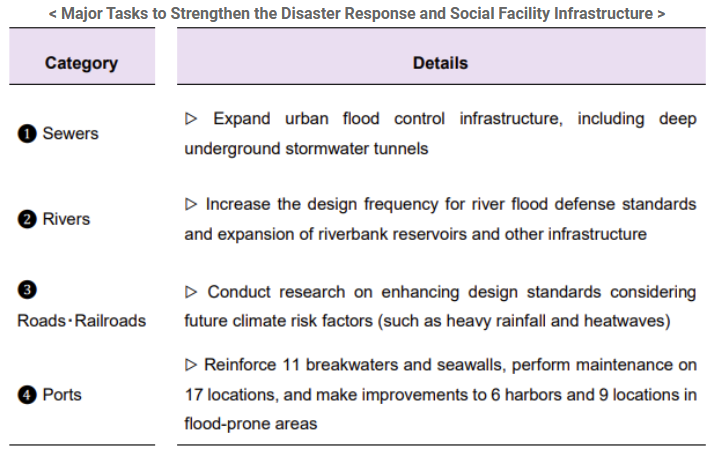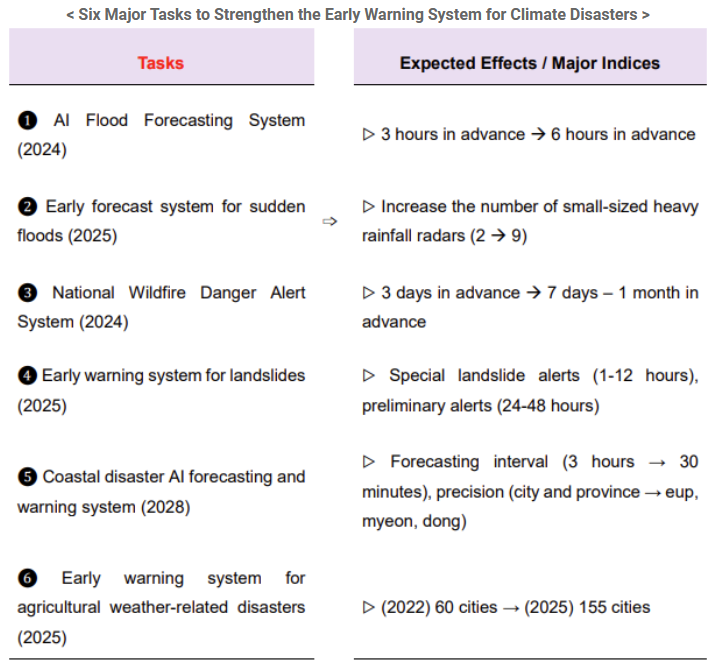Korea's Recent Environmental Laws, Reports, and Press Releases based on KEI Research
- Date2023-07-07 11:08
- TypePress Release
- View116
▷ The plan will improve and expand infrastructure that reflects the future climate risks. It also aims to strengthen the safety net by conducting a survey for the first time targeting vulnerable groups
Sejong, July 4 - The Ministry of Environment (Minister Han Wha-jin) has announced the official ation of the "3rd National Climate Crisis Adaptation Plan." This plan, jointly prepared by relevant ministries, underwent deliberation at the 4th plenary meeting of the Presidential Commission on Carbon Neutrality and Green Growth. The meeting was held at the Seoul Government Complex on June 22.
With the release of new climate projections by the Intergovernmental Panel on Climate Change (IPCC) on February 27, 2022, and the exacerbation of climate-related disasters, the government recognized the need to enhance the existing "3rd National Climate Change Adaptation Plan (2021-2025)" established on December 14, 2020. Due to limitations in preventing and mitigating the intensifying climate crisis, the government developed this new plan. It aims to strengthen the adaptation infrastructure and formulate an action plan that can be implemented at the field level.
The newly established "3rd National Climate Crisis Adaptation Plan" includes the following key measures to address the challenges: △Enhance scientific aspects of climate monitoring and climate systems and improve public access to adaptation information; △Improve the social infrastructure to reflect the future climate risks; △Strengthen early s and warnings regarding climate disasters and minimize damage for vulnerable groups; and △Promote climate adaptation where everyone can play their individual roles. The details are as follows.
First, the plan aims to enhance the scientific aspects of climate monitoring and prediction systems and improve public access to adaptation information. It seeks to improve climate change predictions (scenarios) by considering future trends such as population and energy consumption. Detailed climate change situation maps will be provided at the eup, myeon, and dong levels. The plan also aims to expand the greenhouse gas ground observation network. Three-dimensional observation networks that incorporate satellite data will be utilized to scientifically evaluate mitigation and adaptation policies. An integrated adaptation information platform will be developed to consolidate and provide climate adaptation information from various agencies, enhancing accessibility for the public. Climate risk maps that visualize risks such as heatwaves and droughts will also be available.
Second, the plan aims to expand infrastructure to overcome climate-related disasters and create a safe society. To enhance flood defense capabilities, the frequency of design for flood preparation for small rivers will be increased. This increase will be from once in 100 years to once in 200 years. There will be more relevant adaptation infrastructure, such as deep underground stormwater tunnels, underground drainage systems, and riverbank reservoirs. To effectively respond to droughts, dam-weir-estuary barrage will be scientifically coordinated and operated, and the capacity of large-scale reservoirs (5 million ㎡) as well as medium- and small-scale reservoirs (300,000 ㎡) will be increased. When formulating basic plans for local governments, there will be improvements to guidelines to analyze vulnerability to disasters and develop disaster mitigation plans. Measures to enhance road and railway design standards considering climate risks such as heatwaves and heavy rainfall will be reviewed. Design standards for ports and harbors will also be comprehensively improved, taking into account characteristics such as coastal features and wave conditions.

Third, efforts will be made to enhance disaster response capabilities and minimize the damage to the public by strengthening early warning and systems. The introduction of Artificial Intelligence (AI) flood forecasting systems will enable faster forecasts and s, extending the lead time from three hours to six hours in advance. To enhance proactive wildfire preparedness, the provision of wildfire prediction information will be expanded from the previous short-term (three days in advance) to include the medium-term (seven days in advance) and long-term (one month in advance) forecasts. Information on meteorological drought will also be expanded to cover a period of more than three months. To ensure that sudden and extreme heavy rainfall information will be disseminated quickly, the Korea Meteorological Administration will directly send mobile phone messages to the public. Additionally, information on heatwaves and cold spells will be transmitted both by community broadcasts and mobile text messages. This will help mitigate heat-related and cold-related illnesses among vulnerable elderly individuals and outdoor workers. Furthermore, the National Center for Disaster and Trauma will provide psychological support for individuals affected by climate disasters.

Fourth, the plan includes strengthening national protection for climate-vulnerable groups and establishing a cooperation framework (governance) for adaptation. For the first time, the government will conduct a survey on vulnerable groups. The purpose is to develop protective measures, promote the renovation of disaster-prone housing, and provide support for residents' relocation. Administrative planning will incorporate adaptation measures by strengthening institutional provisions and the legal foundation related to climate adaptation, which includes surveys on vulnerable groups. The government will also develop approaches to incorporate climate change risk assessment into budget reviews. It will also establish a methodology for cross-sectoral collaboration and joint evaluation of adaptation-mitigation co-benefits. These efforts will be made to enhance the effectiveness of adaptation policies. Sector-specific cooperation will be increased to create a climate-adaptive society through climate-adaptation forums involving participating groups (citizens, youth organizations) as well as relevant government agencies. Local governments will be encouraged to increase investment in the disaster safety budget. This will be achieved by reflecting the disaster safety budget of local governments (budget execution and settlement) when allocating fire safety grants. Lastly, the industry and financial sectors will be given more climate adaptation measures. These approaches will include pilot projects for risk assessment of aging industrial complexes and the development of guidelines for climate risk management in financial institutions.
Minister Han Wha-jin stated, "We will establish a societal adaptation foundation that can proactively prevent future climate risks based on scientific predictions of intensifying climate change." She added, "Through collaboration with all adaptation stakeholders, including citizens, local governments, civil society, and industries, we will actively pursue climate adaptation measures."
[Source: Press Release (me.go.kr)]
